Statistics > EXAM > QNT 561 FINAL EXAM - QUESTIONS AND ANSWERS (All)
QNT 561 FINAL EXAM - QUESTIONS AND ANSWERS
Document Content and Description Below
QNT 561 FINAL EXAM - QUESTIONS AND ANSWERS A difference between calculating the sample mean and the population mean is A) Only in the symbols, we use instead of μ and n instead of N B) We divide th... e sum of the observations by n - 1 instead of n. C) The observations are ranked and select the middle value for the population mean. D) There are no differences. 2) Which of the following measures of central location is affected most by extreme values? A) Median B) Mean C) Mode D) Geometric mean 3) Which level of measurement is required for the median? A) Nominal B) Ordinal C) Interval D) Ratio 4) Which level of measurement is required for the mode? A) Nominal B) Ordinal C) Interval D) Ratio 5) In a set of observations, which measure of central tendency reports the value that occurs most often? A) Mean B) Median C) Mode D) Geometric mean 6) The weighted mean is a special case of the A) Mean B) Median C) Mode D) Geometric mean 7) The relationship between the geometric mean and the arithmetic mean is A) They will always be the same. B) The geometric mean will always be larger. C) The geometric mean will be equal to or less than the mean. D) The mean will always be larger than the geometric mean. 8) Suppose you compare the mean of raw data and the mean of the same raw data grouped into a frequency distribution. These two means will be A) Exactly equal. B) The same as the median. C) The same as the geometric mean. D) Approximately equal. 9) In a set of 10 observations the mean is 20 and the median is 15. There are 2 values that are 6, and all other values are different. What is the mode? A) 15 B) 20 C) 6 D) None of the above. 10) Which of the measures of central tendency is the largest in a positively skewed distribution? A) Mean B) Median C) Mode D) Cannot tell from the information given. 11) Which of the following is not a measure of dispersion? A) Range B) Variance C) Standard deviation D) All of the above are measures of dispersion 12) A disadvantage of the range is A) Only two values are used in its calculation. B) It is in different units than the mean. C) It does not exist for some data sets. D) All of the above. 13) The mean deviation is A) Based on squared deviations from the mean. B) Also called the variance. C) Based on absolute values. D) Always reported in squared units. 14) The standard deviation is A) Based on squared deviations from the mean. B) In the same units as the mean. C) Uses all the observations in its calculation. D) All of the above. 15) The variance is A) Found by dividing by N by the mean. B) In the same units as the original data. C) Found by squaring the standard deviation. D) All of the above. 16) In a positively skewed distribution A) The mean, median, and mode are all equal. B) The mean is larger than the median. C) The median is larger than the mean. D) The standard deviation must be larger than the mean or the median. 17) Which of the following statements is true regarding the standard deviation? A) It cannot assume a negative value. B) If it is zero, then all the data values are the same. C) It is in the same units as the mean. D) All the above are all correct. 18) Under which of the following conditions would the standard deviation assume a negative value. A) When all the data values were negative. B) When more than half of the data values were negative. C) If all the data values were the same. D) The standard deviation cannot be negative. 19) For a stem-and-leaf display A) Arrange the leaf values from smallest to largest. B) Make sure the stem value is only one digit. C) Do not allow stems with no leaf values. D) All of the above. 20) Reference: Ref4-1 Questions 2 to 6 refer to the following information. It reports the number of TV sets sold per day at the Appliance Center. 1 1 333 2 6 3 00234 4 5 1234 6 56788 7 8 8 This arrangement is called a A) Frequency distribution B) A frequency polygon C) A pie chart D) A stem-and-leaf chart 21) How many days were studied? A) 11 B) 30 C) 50 D) None of the above 22) What was the smallest and largest number of sets sold per day? A) 1, 8 B) 10, 80 C) 11,88 D) None of the above 23) How many days were there less than 30 sets sold? A) 15 B) 6 C) 30 D) None of the above 24) The actual number of sets sold per day between 60 and 69 is A) 65, 66, 67, 68, 68 B) 60, 69 C) Cannot tell from the information given D) None of the above 25) The quartile deviation is A) The square root of the variance. B) Based on the middle 50 percent of the observations. C) In squared units of the original data. D) Appropriate only for symmetric distributions. 26) In a symmetric distribution A) The mean, median, and mode are equal. B) The mean is the largest measure of location. C) The median is the largest measure of location. D) The standard deviation is the largest value. 27) A coefficient of skewness of -2.73 was computed for a set of data. We conclude that A) The mean is larger than the median. B) The median is larger than the mean. C) The standard deviation is a negative number. D) Something is wrong because the coefficient of skewness cannot be less than -1.00. 28) A scatter diagram: A) Is a graphic tool designed to portray the relationship between variables. B) Uses interval or ratio scale data. C) Does not allow negative values. D) Both A and B are correct. 29) Which of the following is a correct statement about a probability? A) It may range from 0 to 1. B) It may assume negative values. C) It may be greater than 1. D) It cannot be reported to more than 1 decimal place. 30) An experiment is a A) Collection of events. B) Collection of outcomes. C) Always greater than 1. D) The act of taking a measurement or the observation of some activity. E) None of the above is correct. 1) Which of the following is not a type of probability? A) Subjective B) Independent C) Relative frequency D) Classical 2) Events are independent if A) By virtue of one event happening another cannot. B) The probability of their occurrence is greater than 1. C) We can count the possible outcomes. D) The probability of one event happening does not affect the probability of another event happening. E) None of the above. 3) The Special Rule of Addition is used to combine A) Independent events. B) Mutually exclusive events C) Events that total more than one. D) Events based on subjective probabilities E) Found by using joint probabilities. 4) We use the General Rule of Multiplication to combine A) Events that are not independent. B) Mutually exclusive events. C) Events that total more than 1.00. D) Events based on subjective probabilities E) Found by using joint probabilities. 5) When we find the probability of an event happening by subtracting the probability of the event not happening from 1, we are using A) Subjective probability B) The complement rule. C) The general rule of addition. D) The special rule of multiplication E) Joint probability 6) When we determine the number of combinations A) We are really computing a probability. B) The order of the outcomes is not important. C) The order of the outcomes is important. D) We multiple the likelihood of two independent trials. E) None of the above. 7) Bayes' Theorem A) Is an example of subjective probability B) Can assume of value less than 0. C) Is used to revise a probability based on new or additional information. D) Is found by applying the complement rule. E) None of the above. 8) The difference between a permutation and a combination is: A) In a permutation order is important and in a combination it is not. B) In a permutation order is not important and in a combination it is important. C) A combination is based on the classical definition of probability. D) A permutation is based on the classical definition of probability. E) None of the above. 9) The difference between a random variable and a probability distribution is A) A random variable does not include the probability of an event. B) A random variable can only assume whole numbers. C) A probability distribution can only assume whole numbers. D) None of the above. 10) Which of the following is not a requirement of a binomial distribution? A) A constant probability of success. B) Only two possible outcomes. C) A fixed number of trails. D) Equally likely outcomes. 11) The mean and the variance are equal in A) All probability distributions. B) The binomial distribution. C) The Poisson distribution. D) The hypergeometric distribution. 12) In which of the following distributions is the probability of a success usually small? A) Binomial B) Poisson C) Hypergeometric D) All distribution 13) Which of the following is not a requirement of a probability distribution? A) Equally likely probability of a success. B) Sum of the possible outcomes is 1.00. C) The outcomes are mutually exclusive. D) The probability of each outcome is between 0 and 1. 14) For a binomial distribution A) n must assume a number between 1 and 20 or 25. B) ? must be a multiple of .10. C) There must be at least 3 possible outcomes. D) None of the above. 15) Which of the following is a major difference between the binomial and the hypergeometric distributions? A) The sum of the outcomes can be greater than 1 for the hypergeometric. B) The probability of a success changes from trial to trial in the hypergeometric distribution. C) The number of trials changes in the hypergeometric distribution. D) The outcomes cannot be whole numbers in the hypergeometric distribution. 16) In a continuous probability distribution A) Only certain outcomes are possible. B) All the values within a certain range are possible. C) The sum of the outcomes is greater than 1.00 D) None of the above. 17) For a binomial distribution with n = 15 as ? changes from .50 toward .05 the distribution will A) Become more positively skewed. B) Become more negatively skewed C) Become symmetrical. D) All of the above. 18) The expected value of the a probability distribution A) Is the same as the random variable. B) Is another term for the mean. C) Is also called the variance. D) Cannot be greater than 1. 19) The normal distribution is a A) Discrete distribution B) Continuous distribution. C) Positively skewed distribution D) None of the above. 20) Which of the following are characteristics of the normal distribution? A) It is a symmetric distribution. B) It is bell-shaped. C) It is asymptotic. D) All of the above. 21) Which of the following are correct statements about a normal distribution? A) It cannot assume negative numbers. B) It is defined by its mean and standard deviation. C) All normal distributions have a variance of at least [Show More]
Last updated: 1 year ago
Preview 1 out of 25 pages
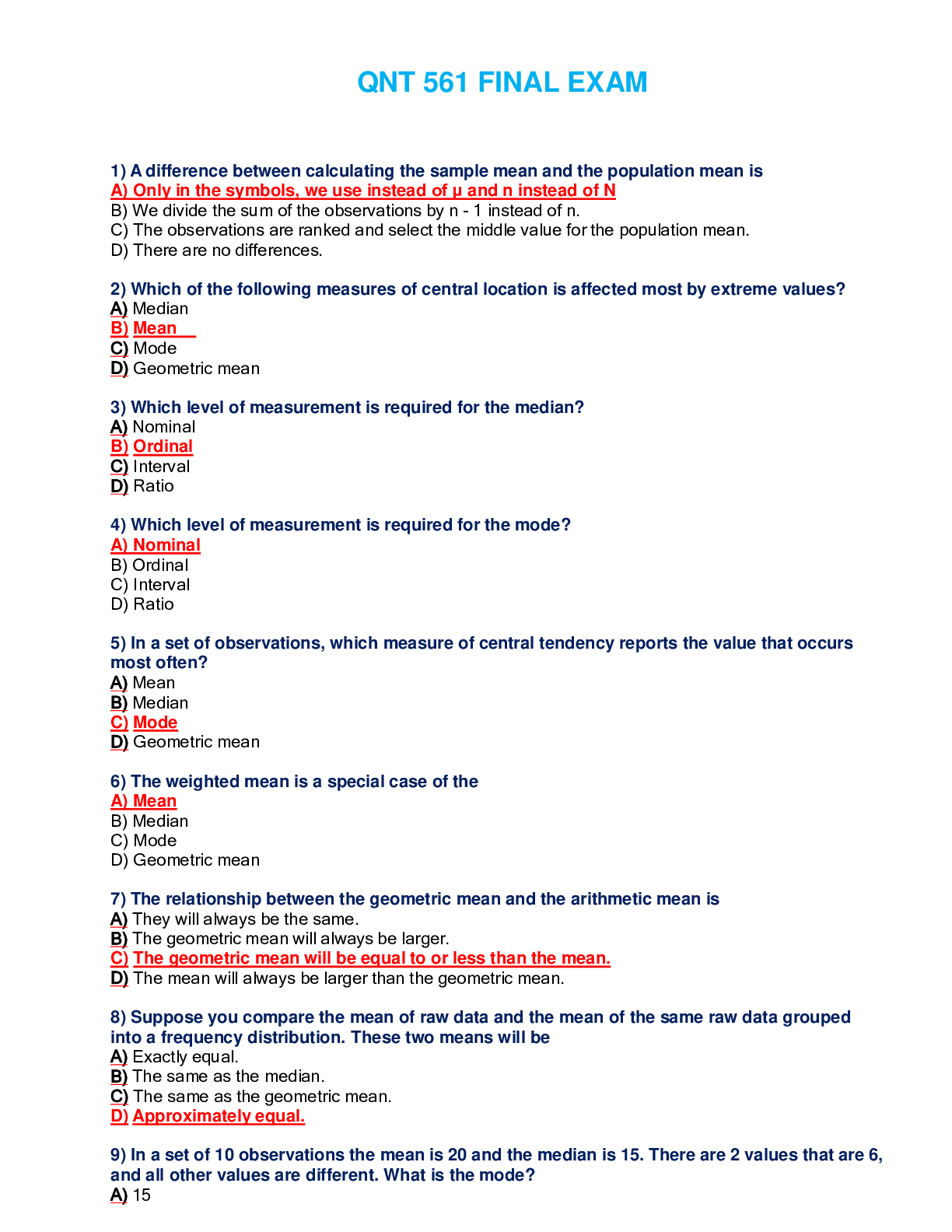
Reviews( 0 )
Recommended For You
Religious Studies> EXAM > CWV TOPIC 2 QUIZ. QUESTIONS AND ANSWERS LATEST UPDATED. (Score 100%) (All)

CWV TOPIC 2 QUIZ. QUESTIONS AND ANSWERS LATEST UPDATED. (Score 100%)
CWV TOPIC 2 QUIZ QUESTIONS AND ANSWERS LATEST UPDATED
By ELIANA , Uploaded: Aug 01, 2022
$9
*NURSING> EXAM > NGR 6172 Pharm Midterm Exam- Questions and Answers. Score 98% (All)
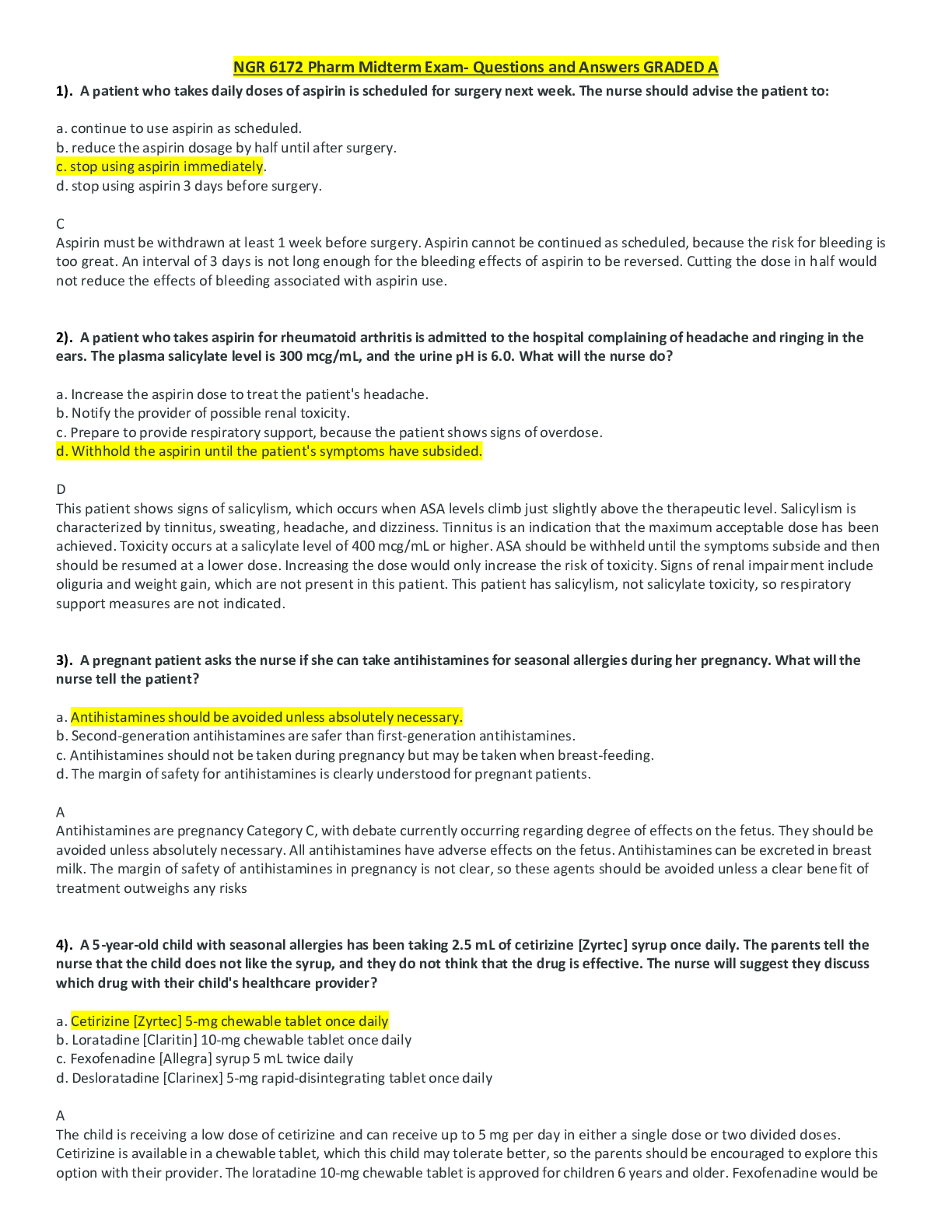
NGR 6172 Pharm Midterm Exam- Questions and Answers. Score 98%
NGR 6172 Pharm Midterm Exam- Questions and Answers GRADED A-1). A patient who takes daily doses of aspirin is scheduled for surgery next week. The nurse should advise the patient to: a. continue to...
By PROF , Uploaded: Feb 01, 2022
$11
Philosophy> EXAM > Intro to Ethics PHL 200 Unit 1 - Questions and Answers (All)

Intro to Ethics PHL 200 Unit 1 - Questions and Answers
PHL 200 Intro to Ethics Unit 1 Which of the following statements best describes the relationship between philosophy and science? Which of the following is a philosophical question? Which of the follow...
By Ajay25 , Uploaded: Jan 04, 2022
$9
Philosophy> EXAM > PHL 200 Introduction to Ethics Unit 4 - Questions and Answers (All)
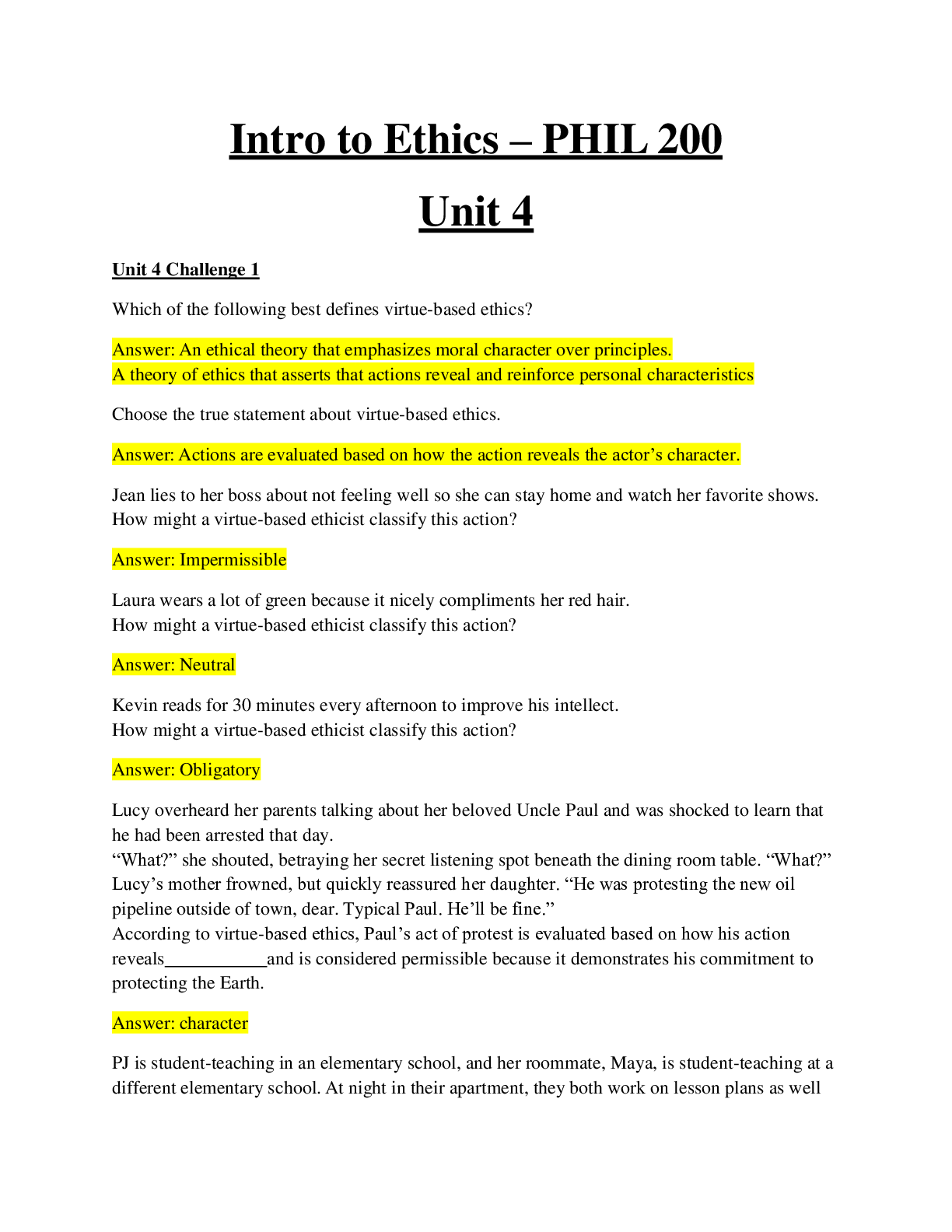
PHL 200 Introduction to Ethics Unit 4 - Questions and Answers
PHL 200 Intro to Ethics Unit 4 Which of the following best defines virtue-based ethics? Choose the true statement about virtue-based ethics. Jean lies to her boss about not feeling well so she can sta...
By Ajay25 , Uploaded: Jan 04, 2022
$10
Health Care> EXAM > NAPRx CNPR Exam WITH 160 Questions and Answers (All)
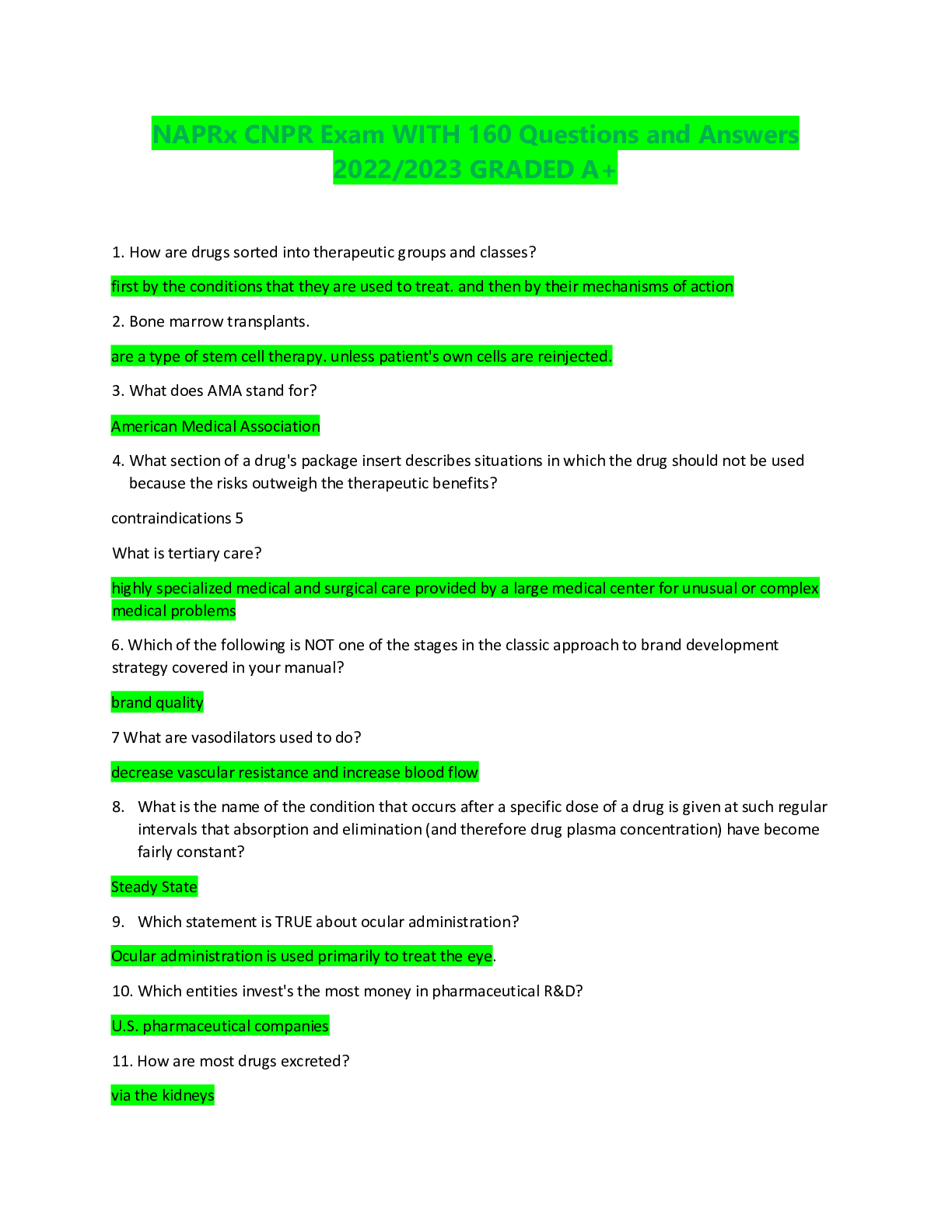
NAPRx CNPR Exam WITH 160 Questions and Answers
NAPRx CNPR Exam WITH 160 Questions and Answers 2022NAPRx CNPR Exam WITH 160 Questions and Answers 2022NAPRx CNPR Exam WITH 160 Questions and Answers 2022NAPRx CNPR Exam WITH 160 Questions and Answers...
By Otieno , Uploaded: Jan 25, 2023
$14
*NURSING> EXAM > HESI RN EXIT Exam V6 Full 160 Questions and Answers (All)
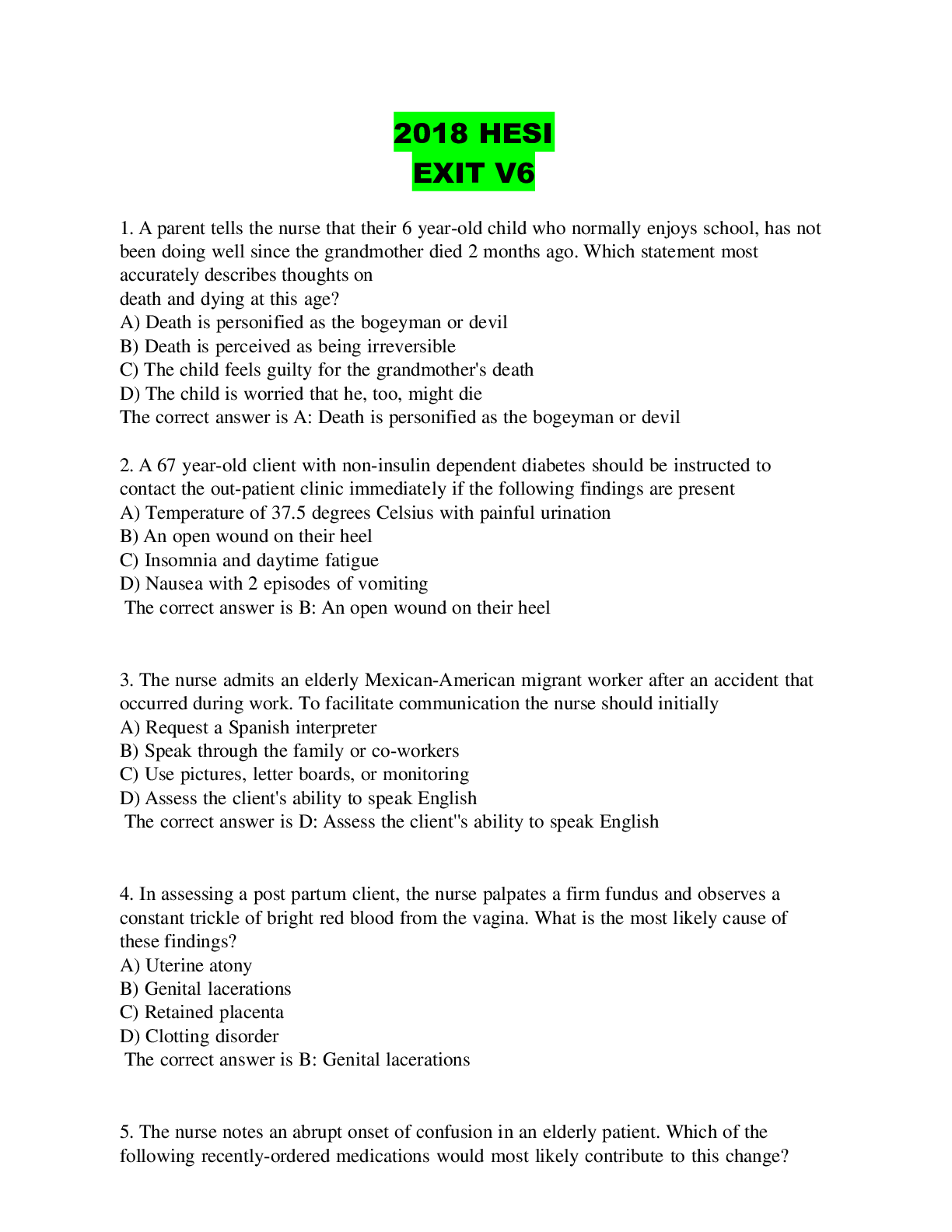
HESI RN EXIT Exam V6 Full 160 Questions and Answers
2021/2022 HESI RN EXIT EXAM V6 FULL 160 QUESTIONS AND ANSWERS./2021/2022 HESI RN EXIT EXAM V6 FULL 160 QUESTIONS AND ANSWERS.
By Grade A+ , Uploaded: May 16, 2022
$12
*NURSING> EXAM > Hesi Exit 5 - Contains 160 Questions And Answers (All)
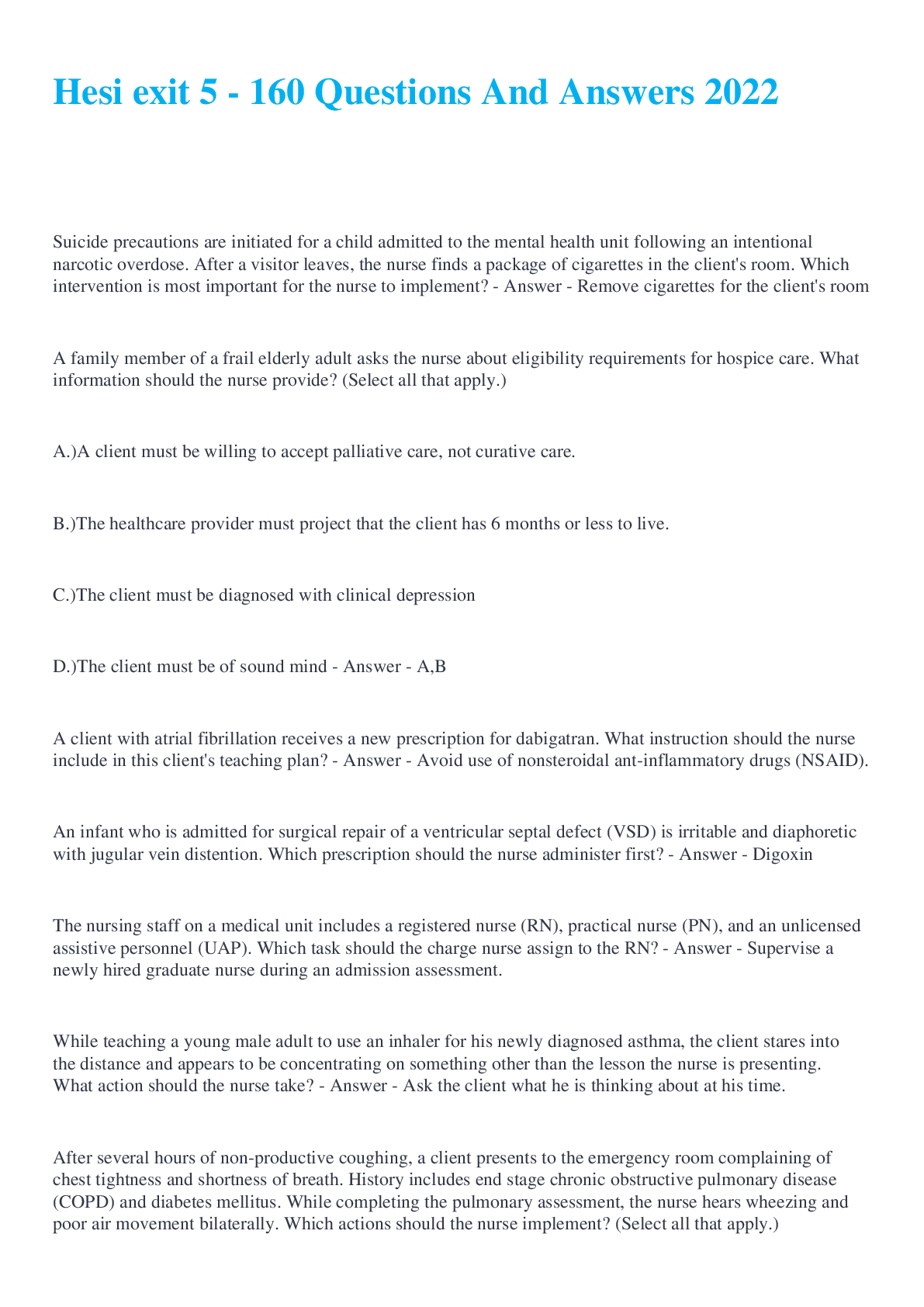
Hesi Exit 5 - Contains 160 Questions And Answers
Hesi exit 5 - 160 Questions And Answers 2022
By SUMMER , Uploaded: Aug 08, 2022
$14
*NURSING> EXAM > ATI RN Mental Health Online Practice B - 60 Questions and Answers (All)
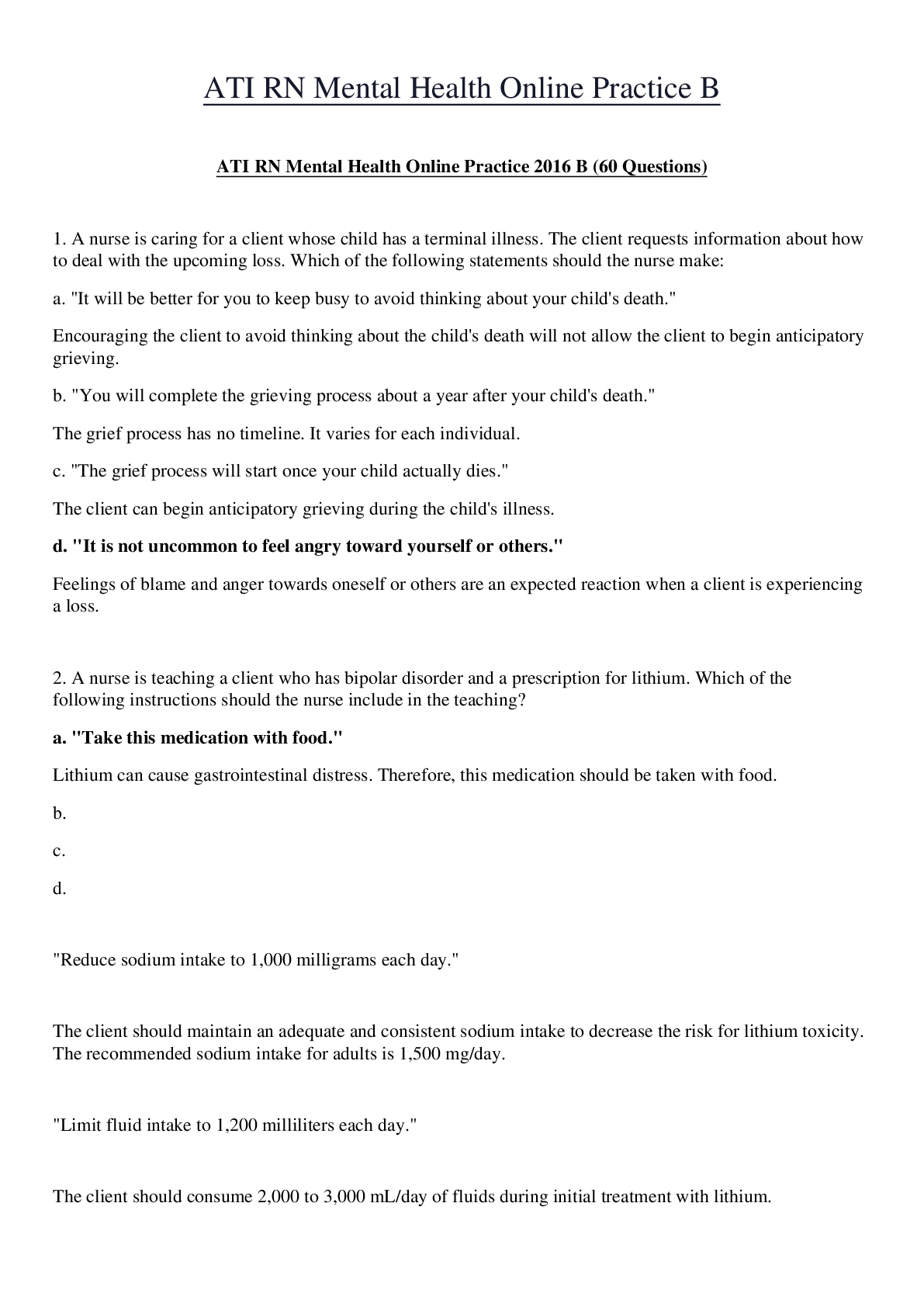
ATI RN Mental Health Online Practice B - 60 Questions and Answers
ATI RN Mental Health Online Practice B ATI RN Mental Health Online Practice 2016 B (60 Questions) 1. A nurse is caring for a client whose child has a terminal illness. The client requests inform...
By Martin Freeman , Uploaded: Jun 07, 2020
$14
Applied Science> EXAM > RBT Training Flashcards - RBT Training Modules | 281 Questions and Answers 100% Correct | COMPLETE | 42 Pages (All)
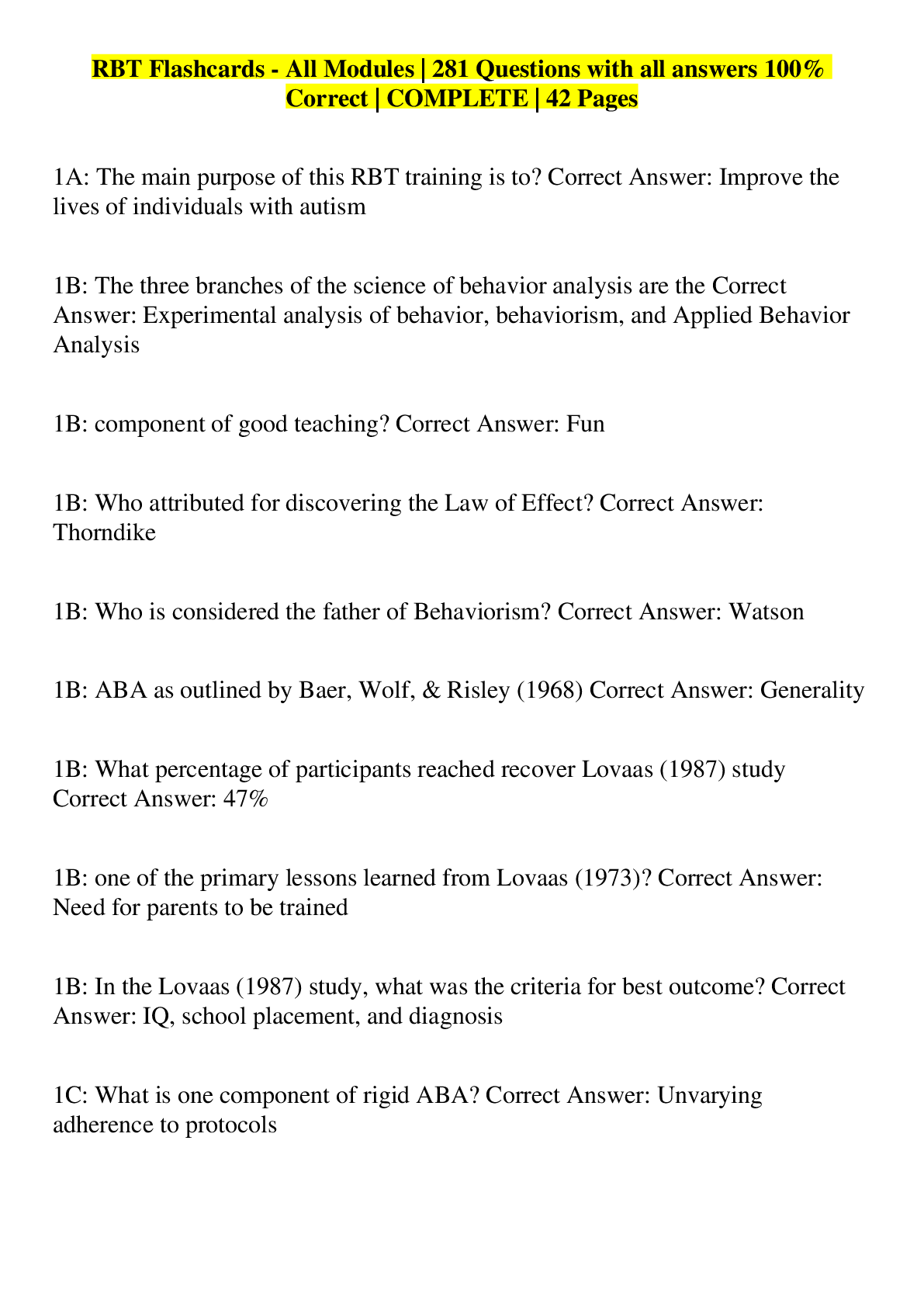
RBT Training Flashcards - RBT Training Modules | 281 Questions and Answers 100% Correct | COMPLETE | 42 Pages
1A: The main purpose of this RBT training is to? - ✔✔Improve the lives of individuals with autism 1B: The three branches of the science of behavior analysis are the - ✔✔Experimental analysis of beh...
By Tessa , Uploaded: Aug 08, 2022
$12
*NURSING> EXAM > NUR2488 - NUR 2488 Mental Health Nursing Final Exam - Rasmussen (All)
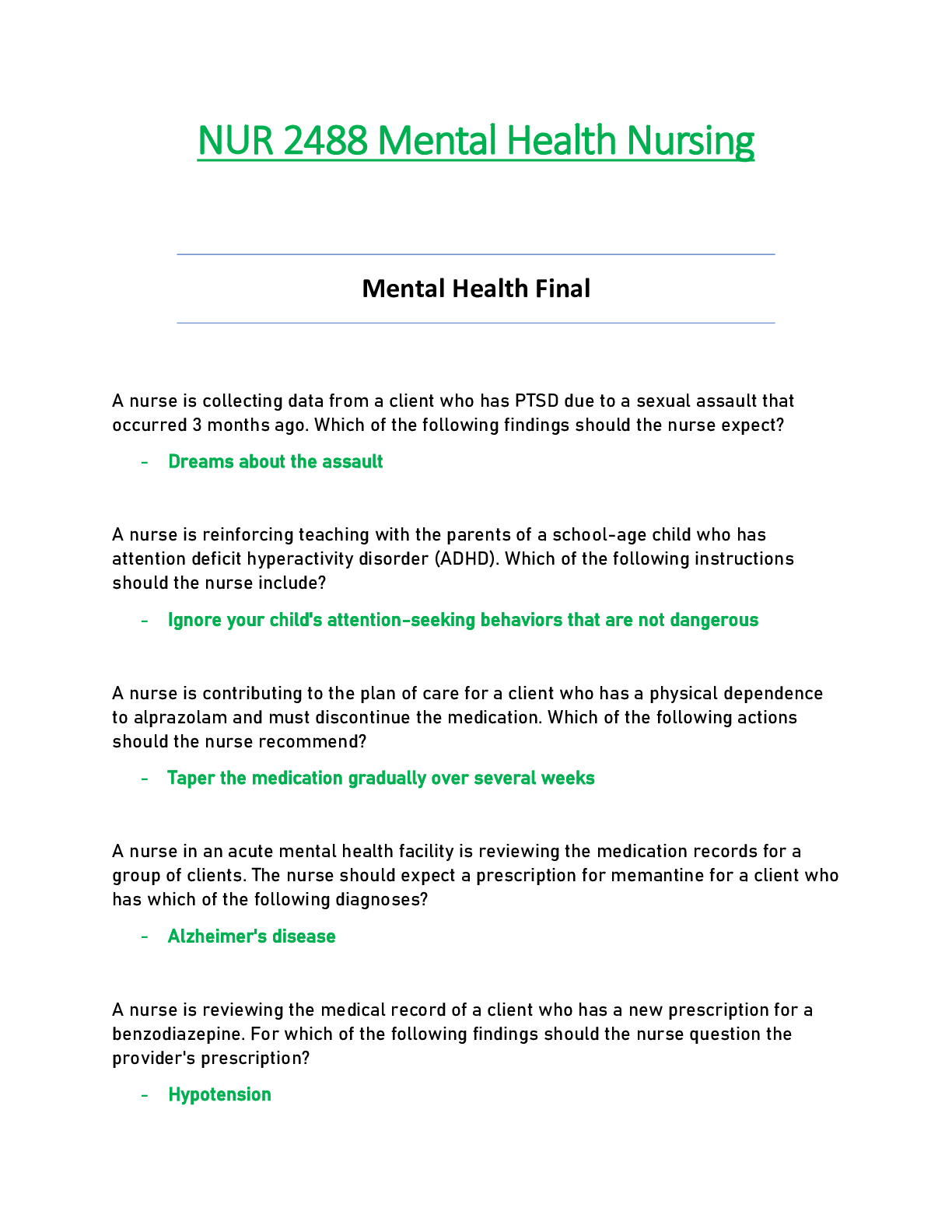
NUR2488 - NUR 2488 Mental Health Nursing Final Exam - Rasmussen
Mental Health Final NUR 2488 Mental Health Nursing Mental Health Final A nurse is collecting data from a client who has PTSD due to a sexual assault that occurred 3 months ago. Which of the...
By quiz_bit , Uploaded: May 30, 2021
$10
Document information
Connected school, study & course
About the document
Uploaded On
Dec 07, 2022
Number of pages
25
Written in
Additional information
This document has been written for:
Uploaded
Dec 07, 2022
Downloads
0
Views
42






